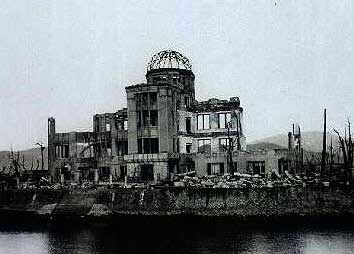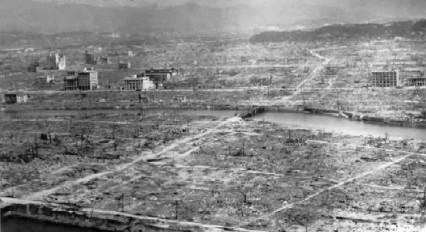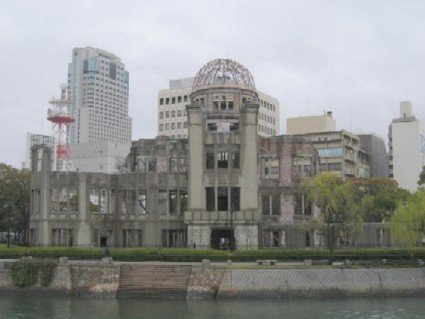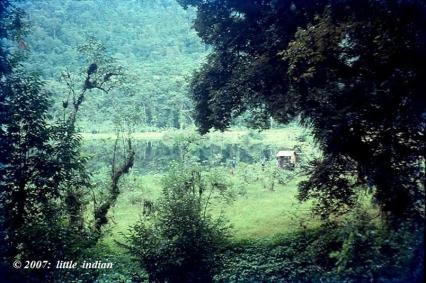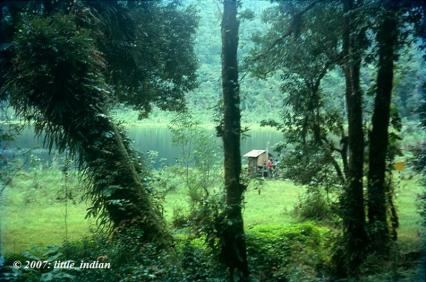[continuing from – Hiroshima …
At Hiroshima,
Japan had learnt of America’s destructive powers.
A city with a third of its population had been vapourised,
while another third were injuried, burnt and were soon to die.

One Hiroshima was not going to win a War, if the sole aim of America
was to terrify the people of Japan, they had certainly achieved it.
Then why did they plan to drop further bombs?
Did they really believe that another Hiroshima was necessary?
And another, and another, and another, and another, and another…
till Japan surrendered or till Japan ceased to exist?
For there is documentary evidence that the intentions were
to drop more atomic bombs as soon as other bombs were made ready for use.
AFTER Hiroshima,
warning leaflets had been dropped
on cities in Japan warning civilians about further attacks with the atomic bomb.
These were the words on the leaflets dropped on August 6, 1945
Source: Harry S. Truman Library,
Miscellaneous historical document file, no. 258.
TO THE JAPANESE PEOPLE:
America asks that you take immediate heed of what we say on this leaflet.
We are in possession of the most destructive explosive ever devised by man. A single one of our newly developed atomic bombs is actually the equivalent in explosive power to what 2000 of our giant B-29s can carry on a single mission. This awful fact is one for you to ponder and we solemnly assure you it is grimly accurate.
We have just begun to use this weapon against your homeland. If you still have any doubt, make inquiry as to what happened to Hiroshima when just one atomic bomb fell on that city.
Before using this bomb to destroy every resource of the military by which they are prolonging this useless war, we ask that you now petition the Emperor to end the war. Our president has outlined for you the thirteen consequences of an honorable surrender. We urge that you accept these consequences and begin the work of building a new, better and peace-loving Japan.
You should take steps now to cease military resistance. Otherwise, we shall resolutely employ this bomb and all our other superior weapons to promptly and forcefully end the war.
EVACUATE YOUR CITIES.
These warnings never reached the people of Hiroshima, it was never intended to,
to cause maximum shock and awe America deliberately killed civilians without warning.
A new form of warfare, the likes of which were never seen before,
was being used to achieving rapid dominance.
ATTENTION JAPANESE PEOPLE – EVACUATE YOUR CITIES.
Because your military leaders have rejected the thirteen part surrender declaration, two momentous events have occurred in the last few days.
The Soviet Union, because of this rejection on the part of the military has notified your Ambassador Sato that it has declared war on your nation. Thus, all powerful countries of the world are now at war with you.
Also, because of your leaders’ refusal to accept the surrender declaration that would enable Japan to honorably end this useless war, we have employed our atomic bomb.
A single one of our newly developed atomic bombs is actually the equivalent in explosive power to what 2000 of our giant B-29s could have carried on a single mission. Radio Tokyo has told you that with the first use of this weapon of total destruction, Hiroshima was virtually destroyed.
Before we use this bomb again and again to destroy every resource of the military by which they are prolonging this useless war, petition the emperor now to end the war. Our president has outlined for you the thirteen consequences of an honorable surrender. We urge that you accept these consequences and begin the work of building a new, better, and peace-loving Japan.
Act at once or we shall resolutely employ this bomb and all our other superior weapons to promptly and forcefully end the war.
EVACUATE YOUR CITIES.
Operation Downfall,
the allied invasion of Japan wasn’t due till November 1945; yet,
after Hiroshima, the Japanese people had been given only two days
to force their rulers to surrender, or they faced certain death by incineration.
These were innocent civilians, being told of a certain and horrifying death,
if their leaders did not comply with the American wishes.
What was the rush to drop the second bomb?
Other than the military uniforms, where is the difference
between the American’s terrorising actions on Japanese civilians of 1945
and the two fatwas of Mr Bin Laden of 1996 and 1998?
The United States has defined terrorism under the Federal Criminal Code.
Section 2331. Definitions:
As used in this chapter –
(1) the term “international terrorism” means activities that –
(A) involve violent acts or acts dangerous to human life …;
(B) appear to be intended –
(i) to intimidate or coerce a civilian population;
(ii) to influence the policy of a government by intimidation or coercion; or
(iii) to affect the conduct of a government by mass destruction, assassination, or kidnapping; and
In 1945, whatever was the desired outcome,
whatever was the justifications for dropping these bombs,
America had terrorised and killed hundreds and thousands of innocent civilians.
America has done it all before.
Nagasaki
Did not receive any warnings,
Their death sentence had been signed,
62 years ago today, Nagasaki was already
a dead city…..living on borrowed time, borrowed until tomorrow…
![]() America
America![]() WWII
WWII![]() History
History![]() Atomic Bomb
Atomic Bomb![]() Hiroshima
Hiroshima![]() War crime
War crime
… continued as – Nagasaki]


